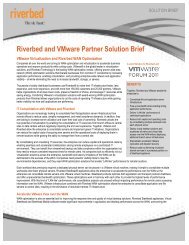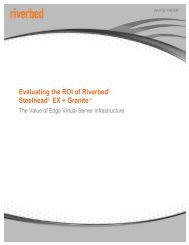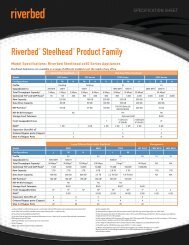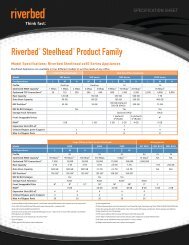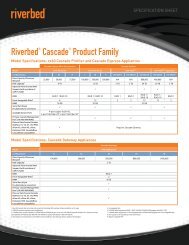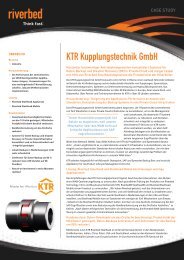Riverbed Optimization System (RiOS) 6.1
Riverbed Optimization System (RiOS) 6.1
Riverbed Optimization System (RiOS) 6.1
Create successful ePaper yourself
Turn your PDF publications into a flip-book with our unique Google optimized e-Paper software.
<strong>RiOS</strong> Technical Overview<br />
appliance to a Steelhead appliance and is meaningful only to those appliances, so Correct Addressing sends that traffic using the<br />
appliance addresses. . When performing Correct Addressing, <strong>RiOS</strong> also utilizes port 7800 for optimized traffic flows by default.<br />
Using this dedicated port in Correct Addressing mode does not tunnel traffic over the WAN. Instead, the traffic remains unencapsulated<br />
and TCP flows are proxied on a one-to-one basis for each connection.<br />
Correct Addressing is the most commonly implemented visibility mode for <strong>Riverbed</strong> customers, because it is the easiest and most<br />
reliable mode to deploy. Many organizations also use Correct Addressing in conjunction with real-time traffic such as VoIP,<br />
videoconferencing, and other QoS traffic, and <strong>RiOS</strong> functions seamlessly in this mode. In addition, Steelhead appliances and<br />
Virtual Steelhead, using Correct Addressing can perform NetFlow exports for customers who desire greater visibility as well. The<br />
diagram below shows how traffic is essentially NATed as it traverses the infrastructure.<br />
Figure-4: Correct Addressing mode uses Steelhead appliance addresses and ports over the WAN This is the default mode of operation and the vast majority of<br />
implementations are deployed in this fashion.<br />
Correct Addressing plus Port Transparency<br />
Correct Addressing plus Port Transparency introduces a mild form of “spoofing” for the traffic sent over the WAN. Although the<br />
appliances are actually sending optimized traffic that looks different to network inspection devices than the “original” un-optimized<br />
traffic, Port Transparency uses those same original source and destination ports for optimized traffic sent across the WAN.<br />
However, in this mode the WAN traffic is still addressed to and from the appliances’ IP addresses – only the port information is<br />
spoofed. Customers using this mode keep the benefits of Correct Addressing in terms of reliability and ease of deployment, and<br />
also gain the ability to solve some problems that are more easily addressed by spoofing ports. For example, integrating into some<br />
port-based traffic classification or reporting systems on the WAN side of Steelhead appliances or Virtual Steelhead can be easier<br />
by using Port Transparency.. Port Transparency still needs to be used with some caution since it can lead to unexpected results,<br />
especially with any technologies that inspect traffic and check for anomalies; but it also has the significant benefit of avoiding the<br />
more dangerous risks associated with spoofing source or destination IP addresses.<br />
© 2010 <strong>Riverbed</strong> Technology. All rights reserved. 5




